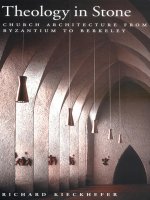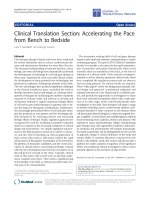Theology in Stone Church Architecture from Byzantium to Berkeley docx
Bạn đang xem bản rút gọn của tài liệu. Xem và tải ngay bản đầy đủ của tài liệu tại đây (4.02 MB, 385 trang )
Theology in Stone:
Church Architecture from
Byzantium to Berkeley
RICHARD KIECKHEFER
OXFORD UNIVERSITY PRESS
Theology in Stone
This page intentionally left blank
Theology in Stone
Church Architecture from
Byzantium to Berkeley
richard kieckhefer
1
2004
1
Oxford New York
Auckland Bangkok Buenos Aires Cape Town Chennai
Dar es Salaam Delhi Hong Kong Istanbul Karachi Kolkata
Kuala Lumpur Madrid Melbourne Mexico City Mumbai
Nairobi Sa˜o Paulo Shanghai Taipei Tokyo Toronto
Copyright ᭧ 2004 by Oxford University Press, Inc.
Published by Oxford University Press, Inc.
198 Madison Avenue, New York, New York 10016
www.oup.com
Oxford is a registered trademark of Oxford University Press
All rights reserved. No part of this publication may be reproduced,
stored in a retrieval system, or transmitted, in any form or by any means,
electronic, mechanical, photocopying, recording, or otherwise,
without the prior permission of Oxford University Press.
Library of Congress Cataloging-in-Publication Data
Kieckhefer, Richard.
Theology in stone : Church architecture from Byzantium to Berkeley /
Richard Kieckhefer.
p. cm.
Includes bibliographical references and index.
ISBN 0-19-515466-5
1. Church architecture. 2. Liturgy and architecture. I. Title.
NA4800 .K53 2003
726.5—dc21 2002153721
Rev.
987654321
Printed in the United States of America
on acid-free paper
To the memory of my mother
Virginia Kelley Kieckhefer
(1917–2002)
This page intentionally left blank
Preface
Church architecture is a contentious field of inquiry. Polemics, dog-
matism, and caricature abound. It would be unrealistic to think any
book could resolve the controversies, but a fresh look at the most
basic questions about churches, their meanings and their uses, may
prove useful to all sides. The incentive to write this book was mixed:
it grew out of historical interest, but also out of an urge to see more
clearly what churches have meant and what they can mean for com-
munities that build and use them. It might seem that the first four
chapters deal with theological questions, while the extended case
studies that follow shift the focus to history—but in fact theology
and history are intertwined throughout.
With a book of this sort, readers may have more than the usual
degree of curiosity about the author’s background and point of view.
Suffice it to say that my most extensive experience of worship has
been in Roman Catholic, Orthodox, and Anglican churches; that I
am old enough to have recited mass responses for many years in
Latin and to have learned plainchant in first grade; that over many
years I have visited churches extensively in Britain and North Amer-
ica and have had occasion to study them in France, Germany, Spain,
Italy, Belgium, the Netherlands, Switzerland, Austria, the Czech Re-
public, and Greece; that I dream of exploring the churches of La¯li-
bala¯—indeed, I literally dream quite often of visiting churches—but
have not yet done so; that my academic research has focused mainly
on western Europe in the late Middle Ages; that my doctorate is in
history but I have taught for decades in a department of religion;
that I have done much work on the history of magic, which I see as
viii preface
relevant to the broader study of ritual; that one of my maternal grandmother’s
uncles was pastor of the first Polish church in Chicago, and some of my in-
formation on Saint Stanislas Kostka Church is from an unpublished family
history; that I have had considerable experience in a Newman Center designed
in the years of experimentation after Vatican II; that I have sung for over a
decade in the choir of an Orthodox cathedral; that I have been deeply involved
at an Anglo-Catholic church where women are welcomed as priests, where
openly gay men and lesbian couples with children occupy positions of lay
leadership, and where liturgy and an exceptionally strong music program are
balanced by ministry to refugees and others; and that if this book is inspired
by any particular theological tradition it is that of liberal Anglo-Catholicism.
The last point may seem the most important but cannot be isolated from all
the rest.
Three people especially have given me the benefit of their wisdom and
learning as I have worked on this project. My wife Barbara Newman shares a
passionate interest in liturgy and its setting and has contributed immeasurably
to the progress of this book at every stage; when I tell of experiences “we” have
had in visiting churches, she is invariably my companion. Frank Burch Brown
read and gave exceptionally detailed and insightful comments on an early draft;
he is largely responsible for giving my research a series of unexpected turns.
And Karl Morrison, who read the book when it was in its longest and untidiest
state, challenged me helpfully on many points in his double role as scholar
and priest.
Various specialists have shown themselves kind and generous with their
expertise: Wolfgang Pehnt gave perceptive comments for the chapter on Rudolf
Schwarz; Rosemary Horrax helped with the chapter on Beverley; Father Mi-
chael Komechak, O.S.B., has showed kindness on many visits to Saint Proco-
pius Abbey, shared his wisdom on contemporary church design, and provided
valuable suggestions on various chapters; and David Van Zanten made clear
how my perspective relates to that of an architectural historian. All these in-
dividuals have contributed immensely toward my project.
I am deeply indebted also to Benjamin D. Sommer for insight into the
conceptions of sacrifice in ancient Israel; to David Collins, S.J., for reactions
to an early draft; to Richard Webster for giving me a musician’s perspective on
the subtleties of church acoustics; to Amelia J. Carr for revealing to me some-
thing of an art historian’s grasp of churches in the Chicago area; to Adhemar
Dellagustina, Jr., for expert help with photographs; to Marian Caudron for
sharing with me her experiences in sacred places; to Edward Muir, for the
subtitle; to Stuart Baumann and Linda Kelley, Roger Boden, Emily Erwin,
Amancio Guedes, Lawrence Haptas, John Kemp, Angela Lorenz, Susan B.
Matheson, Kelli Peters, Maria Schwarz, Claudia Swan, and Michael Swartz, for
various kindnesses; to parishioners at Saint Luke’s in Evanston and to students
at Northwestern University and Seabury-Western Theological Seminary, for
preface ix
giving me the invaluable opportunity to learn by teaching; and to Cynthia Read
at Oxford University Press for proving the ideal editor for a book of this sort.
The interlibrary loan staff at Northwestern University Library have obtained a
constant stream of materials to sustain my research habit. Countless people
have given me invaluable help on my visits to their churches, including at
times the most basic service of providing a key. Unfortunately many of them
are nameless to me. I must at least express gratitude to Father Donald Schell
and Father Richard Fabian, of Saint Gregory of Nyssa in San Francisco, and
Father Johannes Floss and Christa Schinkenmeyer, of Sankt Fronleichnam in
Aachen; and Father Duncan Ross, of Saint Paul’s Bow Common.
The Northwestern University Research Grants Committee has provided
partial support for the publication of this book, and I am grateful for this
assistance.
Over the decades, several church communities have informed my sense
of how ecclesiastical architecture comes alive in a range of liturgical uses: Saint
Thomas More Church in Louisville, where I grew up at a time when the church
building was architecturally unambitious but the liturgy was more richly de-
veloped than I could then appreciate; Sheil Center in Evanston, which accom-
modates with equal grace the throngs of Ash Wednesday and the quiet few on
weekday afternoons; Holy Trinity Orthodox Cathedral in Chicago, known as
the Louis Sullivan church but more importantly a coherent specimen of tra-
ditional Russian design; and Saint Luke’s Episcopal Church in Evanston, which
was begun in the early twentieth century as a classic Anglo-Catholic church
and still (like the Church universal) awaits its finishing touches.
Not all these people and communities would agree with what I have to
say. But I hope, at least, not to have been blind or deaf to what they cherish
and what they have tried to teach me.
This book is dedicated to the memory of my mother, Virginia Kelley Kieck-
hefer, whose contribution to it was by far the most vital: she first took me to a
church for baptism when I was an infant, she took me again when I was a
very young child (I looked about and asked where God was, and she said he
was all around us), she went with me exploring churches even as her health
declined, and now she has passed beyond symbols and metaphors to “that
eternal and blessed church” which others prefigure.
A Note on Illustrations
In addition to the plates given in this book, readers may consult the listing of
churches on the Emporis Web site, . This site gives a
wide selection of images, including many for churches discussed here.
This page intentionally left blank
Contents
Introduction, 3
1. The First Factor: Spatial Dynamics, 21
2. The Second Factor: Centering Focus, 63
3. The Third Factor: Aesthetic Impact, 97
4. The Fourth Factor: Symbolic Resonance, 135
5. Late Medieval Beverley: Traditional Churches in a Traditional
Culture, 167
6. Chicago: Traditional Churches in a Modern Culture, 195
7. Rudolf Schwarz: Modern Churches in a Modern Culture, 229
8. Issues in Church Architecture, 265
Notes, 293
Index, 363
This page intentionally left blank
Theology in Stone
This page intentionally left blank
Introduction
Robertson Davies tells of an English country church where the
women make a slight curtsy to a blank wall on entering. Why they
do so is unclear, until the vicar explains that a statue of the Virgin
once stood at precisely that spot, and Cromwell’s troops destroyed it
in the seventeenth century, yet even these iconoclasts “could not de-
stroy the local habit, as evinced in the women’s behaviour.”
1
The
story is not unique to Davies’s novel. Historians speak of a Conti-
nental church where it is a wall-painting of the Virgin that is plas-
tered over during the Reformation, venerated nonetheless with rev-
erent bows by generations of villagers, then rediscovered in the
course of restoration.
2
Here as elsewhere, the old religion lingers.
The tale lends itself to more than one reading. For Protestant
Reformers or rationalist critics it can be a lesson in the lamentable
tenacity of folk superstition. Just as plausibly it can show how ordi-
nary folk have deeper memory and keener perception of a sacred
presence than iconoclast elites, even if their memory and perception
are embodied in gesture and not explicitly articulated. A modern li-
turgical reformer might see it as a cautionary tale showing how pri-
vate devotion infiltrates liturgical space, while a traditionalist might
brandish it with glee as evidence that liturgy and devotion will go
hand in hand whatever the puritans of any age do to keep them
apart. But neither the skeptical nor the romantic view of such a
story, neither the reformist nor the traditionalist reading, could
claim authority without somehow entering into the scene and speak-
ing with the villagers, giving them occasion to articulate what they
experience. Do they in fact have some awareness, however vague, of
4 theology in stone
a statue or a painting once on view? Does the experience of entering a church
and bowing to a spot on the wall, meaningless as the gesture may seem, help
give a sense of sacred place and prepare for richer experience of worship? The
story brings into focus several issues in the use of sacred space. In the end,
however, it can perhaps best be read as a parable urging everyone—reformist
theologians and lay devotees, secular scholars and other outsiders—to become
more reflective and articulate about what ritual is meant to do, how it gives
expression to faith, and how the space provided for ritual is meant to function.
The plaster concealing the image becomes a metaphor for all that blocks full
realization of the purposes served in liturgy and promoted by liturgical space.
Interesting as it would be to interview the villagers of Davies’s tale, the
opportunity is not likely to arise, not least because the tale comes with an
eyebrow-raising vagueness about exact location. But anyone who makes use of
any church has experience of it as sacred space, and there is no shortage of
opportunities to clarify people’s perceptions by articulating them, by bringing
experience to the level of conception. That, most basically, is the purpose of
this book. It is meant to stimulate thinking about churches; to provoke deeper
and more broadly informed reflection on the purposes of church architecture,
and thus also on the worship carried out in churches; to suggest how one
might go about reading a church; to provide conceptual tools and vocabulary
for articulating experience of sacred space. At a time when church architecture
is an intensely controversial matter, one may well raise the fundamental ques-
tions often obscured in polemics, and reopen possibilities closed off by dog-
matisms.
Responding to Churches
During his travels in 1853 Augustus Hare was disappointed by his companion,
“a good-looking, sentimental, would-be poet,” whose only comment on Co-
logne Cathedral was “very pretty,” and on Sankt Aposteln “very nice.”
3
Even in
an age that prized sentiment more than ours, these sentiments must have
seemed thin indeed. But where does one go beyond “very nice” and “very
pretty”? Would Hare have been any more pleased with a less tepid comment
such as “magnificent!” or “awe-inspiring!” that required no greater mental
exertion than “very pretty”? One might move to the opposite extreme; Edward
Dart said about one of his own churches: “Christianity is not a pretty religion—
I will be disappointed if our church is classed as a pretty church.”
4
Skirting
that issue, one might focus on the historically contextualized particulars of a
specific church, and the cultural milieux that led to some phase of construction
or renovation. One might relate Cologne Cathedral to its seminal role in the
development of German Gothic design, and then to the connection between
the Gothic revival and romantic nationalism of the nineteenth century, while
introduction 5
Sankt Aposteln could bring to mind the flowering of Rhenish Romanesque
and its modern revival.
5
One might walk through these churches discussing
the history and background of each feature, each arcade and window, each altar
and shrine—but without serious study of historical contexts this sort of infor-
mation remains merely anecdotal.
Response to a church are conditioned by culture and by cultural interac-
tion. A writer on African missionary churches noted in 1966 that African
people are more sensitive than Europeans realize to “the atmosphere created
by a building, especially when the building has a high and dignified interior.”
Passersby might come off the road, kneel in even an unfinished building, and
declare: “Truly this is the House of God.”
6
It is hard to say how far such a
statement is spontaneous and uncoached, and how far it reflects the mission-
aries’ teaching. But this is a special instance of a broader phenomenon: reac-
tions learned from others often seem more spontaneous than they are.
Response to a church is conditioned by expectations, yet a church can
frustrate or exceed expectations, even those grounded in long study of photo-
graphs and historical background. I am probably not the only person who has
gone to the Fronleichnamskirche in Aachen fearing the worst, expecting it to
look something like a prison, only to be transfixed on walking through the door
by the flood of pure luminosity, and by the divine stillness that Romano Guar-
dini found in this interior.
7
When Sally Kitt Chappell was planning to visit
Hagia Sophia for the first time, she feared her expectations might be too high.
“Perhaps after all the years of study and anticipation, the work will turn out to
be a disappointment; perhaps one will fail to feel what has moved others so
profoundly.” When she arrived, she found that her expectations had not been
high enough. The dome, supported by the half-dome flanking it, first raised
and then fulfilled her expectations. “This is what a masterpiece does, it expands
your ideas about what is possible.” And the immensity of the light-filled space,
she found, works its magic on all: “Masterpieces succeed universally.” Her
experience was informed by analysis and study of architectural history, yet in
the end it was reverential. “In the peace and light of its radiant spaces, faith
and knowledge celebrate their divine union, wed in the sanctuary of Hagia
Sophia, Holy Wisdom.”
8
Response to a church can depend on whether it is being used liturgically.
Both scholars and enthusiasts often find themselves visiting churches when
they are not in use: as if anaesthetized, the buildings lend themselves more to
examination. Yet even between services a church is not merely an inert func-
tional structure or an aesthetic environment without religious meaning. Paul
Tillich urged that a church building should elicit a response even apart from
its liturgical use, that the space should give people an experience of “the pres-
ence of the holy even before anything else happens within this space.”
9
Or,
as a monk once said of his church, it “prays of itself.”
10
Still, the sense of
sacrality will not be the same in an empty church and a church enlivened by
6 theology in stone
gathering and movement, music and drama. A church is intended by its build-
ers mainly for use by the assembly (which, after all, is what ekklesia or “church”
means in New Testament Greek). In this respect a church is more like a syn-
agogue or mosque than an ancient or Asian temple: it is designed primarily
for an assembly and perhaps secondarily for private use, while a temple is built
primarily for private encounter with the deity or private meditation and sec-
ondarily for communal functions. If one knows well enough what kind of
liturgy is celebrated in a church, even an empty building can be imagined in
use, but liturgists are sometimes full of surprises in their use of space.
Liturgical use of space can give the lie to artificial distinctions. If one
church has an altar in the chancel at the far end, while another church brings
the altar down into the center of the assembly, the buildings may seem to
declare opposing messages even before services have begun. A distinguished
interpreter sees the first sort of church as suggesting that “God is remote and
transcendent,” while the second intimates that “God is near and immanent.”
11
But what if the clergy enter into the nave during the liturgy of the word? What
if the community senses keenly that God is present not only in the eucharist
but in the scriptures, read and preached in the nave, so the altar alone is not
the marker of divine presence? What if the entire assembly moves into the
chancel during the eucharist, making it into a place not of exclusion but of
inclusion? And what if the passage from nave to chancel makes for a more
dynamic, less sedentary worship? The liturgy and the ethos of the place then
overturn the simplistic assumptions grounded in an uncontextualized mis-
reading of the architecture.
The difficulty is compounded when the building is a pilgrimage chapel
specially meant for throngs of devotees but sought out at other times by sight-
seers. John Ely Burchard visited Le Corbusier’s celebrated chapel of Notre
Dame du Haut at Ronchamp and found it in many ways lacking. Yet he con-
ceded that the building might show to proper advantage only at the time of
pilgrimage, when vested priests and throngs of pilgrims stand before the image
of the Virgin for whose veneration they have assembled. His own visit was on
a Sunday when the building swarmed with mere tourists. Photographs of it
devoid of visitors had revealed a unity, an order, that he found missing when
it was packed. “Do you judge it, then, by the repose of the photographs when
no people are there? Might it be that way in mid-week? Was it our bad luck to
come on a Sunday? Or were the people part of the glory of the edifice? A
building for people ought to be able to stand the presence of people, but were
these the right people?”
12
The taste for liturgy, the taste for special religious
events such as pilgrimages, and the taste for sacred space do not always co-
incide, and indeed many people would rather visit and judge a church in con-
templative solitude when it is not buzzing with chant and redolent of incense.
There are even chapels where private prayer is the main intention, and chapels
such as Ronchamp that are meant in the first instance for special devotional
introduction 7
exercises.
13
In these cases the experience of sacrality may be relatively inde-
pendent of regularly celebrated liturgy. But these are special cases. Normally
the reason for entering a church even for private prayer is that the place has a
sacrality derived from association with public prayer, from discovery of a place
where communal prayer, as T. S. Eliot says, has been valid.
On the day in April when I visited Ronchamp, all the other visitors I
encountered were German tourists, a handful of them, whose interest in the
place seemed more cultural than devotional. There was still snow on moun-
taintops not far away, and inside the chapel one could see puffs of one’s own
breath in the air. A quiet rendition of the Regina coeli (it was, after all, only a
few days past Easter) proved the acoustics more hollow than resonant. At an-
other time of the year, at another time of day, under other circumstances, the
chapel would surely have presented a different face, but that day in April it
was like a cave in which spirits had not yet roused themselves from hiberna-
tion.
14
One’s reaction to a church may well be conditioned not only by whether
people are present but by how full or sparse the congregation is. In the early
1950s it was possible to speak of a church by Rudolf Schwarz in which “the
greatness of the space is that priest and congregation are spontaneously
brought together in unity,” even though the priest was standing fully eleven
steps above the congregation and with his back to the people. When both
sanctuary and nave were packed, clergy and servers and congregation seemed
united in a single assembly, and the priest at the altar could be perceived as
standing out among the people, not at all isolated from them.
15
With fewer
people present the same altar in the same position could have fundamentally
different effect.
Response to a church will be conditioned not only by liturgical practice
but also by the ethos of the community. A procession down the center of a
long nave, with a cross borne in the lead, accompanied by candles and perhaps
incense, with clergy in vestments and choir in cassocks and surplices, may
seem to some a meaningless show, a display of clerical grandeur, or a mani-
festation of difference between those processing and those in the pews on
either side. If in a particular parish the clergy are experienced outside of liturgy
as aloof and magisterial, and if the choir members are paid outsiders with little
interest in the life of the parish, this may be precisely the effect of a procession.
But if the clergy are known to be warm pastors or fiery charismatic leaders, if
the choir members are in general active parishioners who wash dishes in the
parish soup kitchen, if there are once and future choristers and acolytes in the
pews, or people who know they could assume these roles if they wished, and
if meanwhile the congregation joins vigorously with the choir in singing while
the procession takes place—if, in short, the clergy and choir are perceived more
as “us” than as “them”—then the procession is likely to be experienced as a
dramatic manifestation of solidarity, an opportunity for clergy and singers to
8 theology in stone
move closer to the congregation, and a means for setting a tone of solemnity
or of celebration. It is not only the liturgy that will be perceived differently, but
the space: the long nave will take on a greater or lesser sense of purpose
depending on how its processional use is experienced. What one person ex-
periences as meaningless show, and a second perceives as dazzlingly impres-
sive show, a third will recognize not as show but as drama.
Churches that represent one extreme or another are likely to elicit a strong
first impression: buildings that are exceptionally soaring, or luminous, or dark
and mysterious, or remarkable for any other unmistakable quality. Lindsay
Jones says of the uncommonly ornate churches of Santa Marı´a Tonantzintla
and San Francisco Acatepec in central Mexico that the first sensation is invar-
iably one of stunned surprise, leading visitors to gasp audibly on entering.
16
The middling church, being neither particularly large nor notably intimate,
neither radiant nor dark, neither strikingly ornate nor singularly pure, neither
very long nor very broad, may be either the most flexible or the most nonde-
script of spaces; its effect will depend all the more on how it is used liturgically
and how the ethos of the community helps define its character. Yet even
churches that do make a striking initial impression may not wear effectively
with repeated exposure or lend themselves equally well to all feasts and sea-
sons. Like liturgy itself, liturgical architecture must overcome the numbing
effect of familiarity, and it can do so only through the ways it is used and the
ethos that is cultivated.
Interested observers sometimes suppose a church will elicit one inevitable
response from all who see and use it. In 1933 a commentator noted that a
certain architectural plan made for “a more worshipful church interior” and
that “with it will come an improvement in the order of worship” because the
improved design would discourage carelessly prepared services.
17
Only a few
years later, in 1940, Eric Gill urged that moving the altar down into the midst
of the congregation would force people to take notice of what is done in liturgy
and compel people to seek and to give instruction on liturgical matters.
18
Even
more extravagantly, a minister in the early 1950s exclaimed of his new interior:
“It would be difficult to speak or think anything but the truth in such a set-
ting.”
19
Yet responses are not so simple and predictable. Architecture does not
force people to do anything. Careless services can be held anywhere. A building
that guarantees truthfulness could only be sought, one might suppose, in the
Heavenly Jerusalem where there is no temple.
The idea of responding to a church takes on different meaning if one
imagines the church as speaking first. Edward So¨vik in the 1960s entertained
a contrast between two churches, one of them large and imposing, the other
more modest. The imposing church he imagined as saying: “I am the ruler;
when you approach me you must be impressed by me, and I want you to move
in certain ways and assume an attitude of awe and subservience in my pres-
ence.” The second church says, more ingratiatingly: “You are people, and you
introduction 9
are the most important thing. I offer you shelter within my powerful structure;
but I will not impose my forms upon you or make myself the demanding
object of your attention Inthis way I will be your servant.”
20
But even apart
from the strangeness of putting words into the mouth of a building, and apart
from one’s suspicion that if the first of these churches could speak it would
strike a rather different rhetorical tone, there is a problem here of misplaced
attribution. If we wanted to sustain the conceit of a church that speaks to
people, we would have to note that the same church says different things to
different visitors. The church that proclaims itself a ruler to one person and
demands homage in response would project to another a message of uplift
and inspiration in the presence of holiness, and it might expect in response
an expression of awe and gratitude to God. But if the church is uttering such
different messages, one quickly suspects that someone is ventriloquizing, and
suspicion falls on interpreters such as So¨vik, who wish their interpretations to
be perceived not as their views projected onto the buildings but as inherent
meanings, as if emanating from the very stones.
Response to a church is learned, and the process of learning requires
informed reflection. The meanings of a church are seldom obvious. One critic
suggests of good architecture generally that it “does not make all its meanings
explicit.”
21
To be sure, another insists that a church has meaning to commu-
nicate, in particular “the meeting of God and man in the bond of love,” and
ought to communicate this meaning to all: “it is no argument to say that some
are insensitive, uncultured, and need first to be educated. This is a means of
education.”
22
People respond spontaneously to ordinary natural and social en-
vironments, and they should be able to grasp the significance of a church in
much the same way. What this argument disregards is that responses to social
environments are not purely spontaneous, and even reactions to nature are
not purely natural: in various ways, explicit and subtle, people learn how to
perceive the world around them, and in the case of a church the lesson is
learned gradually, through experience of liturgy and by life within community,
and by absorbing principles of interpretation learned from others.
Some individuals report an exceptionally keen sensitivity to the presence
of the holy within sacred space. One acquaintance, an eminently practical in-
dividual, handy with a hammer and screwdriver, tells of experiencing physical
reactions to this presence. When she visited Westminster Abbey she had a
sensation of being drawn upward, as if from her heart. At Benares she was
absorbed for nearly an hour in a state of insensate bliss so intense that she
was unaware of a goat nibbling on her jacket. In other sacred places she has
felt a surge of energy running along her spine and up to the crown of her
head. The older the place, and the longer its tradition of worship, the more
intense is her experience. And she has little sympathy for sightseers who treat
a church as merely an object of curiosity. Her sensitivity is perhaps one form
of the mindfulness cultivated in meditation, and it is surely no coincidence
10 theology in stone
that she practices and teaches meditation. But as she relates her experiences
it is clear that she perceives them as coming in response to a presence rooted
not in her but in the places themselves. For her, more than for most people,
the experience of the holy is an experience of reality distinctively present in a
particular location. For her, sacrality is not ascribed to a place but discovered.
This degree of sensitivity may seem unusual. But what counts then as
usual, and why? All ways of responding to a church arise from the particular
backgrounds of specific observers, who will see in it what they have been taught
to see, what their sensibilities lead them to see, and what the uses and ethos
of worshiping communities enable them to see. In the midst of all this varia-
tion, then, it is a challenge to find aspects of church architecture so basic that
they can usefully guide everyone’s perception of any church—to find common
ground for discussion, for possible agreement, and even for clearer under-
standing of the disagreements that will inevitably remain.
Four Ways of Looking at a Church
Two basic questions are relevant to the understanding of any church: how is
it used, and what sort of reaction is it meant to elicit? But each of these ques-
tions can be divided into two more specific questions. To ask how a church is
used is first of all to ask about the overall configuration of space: how is it shaped,
and how does its design relate to the flow, the dynamics of worship? The
question of use is secondly a question about the central focus of attention, if any,
within the church: what is the visual focus, and how does it make clear what
is most important in worship? To inquire about the reaction a church evokes
is to ask first about the immediate impact it makes on a person walking through
the door: what aesthetic qualities come to the fore, and how do they condition
the experience of the holy within the church’s walls? But the question is also
one about the gradual accumulation of impressions gained in repeated experience
of worship within a church: how does sustained exposure to a building and its
markers of sacrality lead to deeper and richer understanding?
One might easily devise thirteen ways of looking at a church, but this book
will suggest four, corresponding to these four fundamental questions: the spa-
tial dynamics of a church, its centering focus, its aesthetic impact, and its
symbolic resonance.
Specialists in the history of church architecture may hear echoes of Fried-
rich Wilhelm Deichmann, who in a classic essay on early churches distin-
guished purpose (Zweck), meaning (Bedeutung), and form (architektonische
Form) as the main factors in church-building.
23
The spatial dynamics and cen-
tering focus of a church might be said to express its purpose, its symbolic
resonance might be taken to express its meaning, and its aesthetic impact could
be assimilated to its form. But Deichmann’s categories refer mainly to the
introduction 11
governing conceptions of the people who planned and built churches, while
my concern is not only with the intention of the builders but also with the
appropriation of churches by generations that view and respond to them, use
them and often refashion them. The question what a church has meant and
the question what a church can mean are related but not identical.
Three Traditions of Church-Building
These four factors are handled differently in different types of church. For
heuristic purposes, this book will survey three broad traditions of church de-
sign (other forms and hybrids could easily be adduced) and will explore how
spatial dynamics, centering focus, aesthetic impact, and symbolic resonance
function in each.
The first tradition, that of the classic sacramental church, stretches back to
the earliest generations of public church-building and claims a rich and ven-
erable history. One of its most familiar forms is sometimes called the basilican
plan, a long structure with lower aisles on either side and an apse at the end.
Variations can be found in Eastern Orthodox, Roman Catholic, and Anglican
parishes, and often in other traditions as well. Its standard features include a
longitudinal nave (mainly for the congregation) and chancel (chiefly for the
clergy), allowing for processions of various kinds from one end to another. The
chancel is traditionally at the east end, the nave at the west. Layout and ter-
minology vary, but one standard arrangement is for the chancel to be subdi-
vided into the sanctuary (with the altar) and the choir (with choir stalls). The
focal point of a classic sacramental church is the altar, the place of sacrament
to which the longitudinal space leads. If a church of this type is based on a
coherent aesthetic vision, it is usually one meant to evoke the immanence of
God and the possibility among worshipers for transcendence of ordinary con-
sciousness. Such churches often abound with symbolic forms and decorations,
making them rich in symbolic resonance. I will refer in more than one chapter
to Santa Maria Maggiore, a basilica of fifth-century Rome, as a classic example
of this form of church (fig. 1).
The second tradition, the classic evangelical church, is meant chiefly for
preaching the gospel. The interior is an auditorium, with the pulpit as its focal
point. Its space is often relatively small, encouraging spontaneous interaction
between preacher and congregation. The main aesthetic goal is to create a space
for edification of individuals and of the congregation. The building itself may
be relatively plain; in any case it will usually be less adorned with symbolic
decorations than a classic sacramental church. Variations on this form were
built by sixteenth-century Huguenots and Dutch reformers. The design was
taken over and transformed at the hands of nineteenth-century urban revival
preachers, and again by modern evangelicals with the latest technology at their
12 theology in stone
figure 1. Santa Maria Maggiore, Rome, interior. Engraving from Giovanni Battista
Piranesi, Vedute di Roma. Reproduction courtesy of The British Library, with per-
mission.
command. I will refer to a seventeenth-century Congregational chapel at Wal-
pole in England as one classic example (fig. 2).
The third tradition, more recent in origin than the others, might be called
the modern communal church. Built for both Protestant and Catholic congre-
gations, this kind of church is meant to emphasize the importance of gathering
people for worship, often around an altar or a pulpit. Such a church is usually
built with ample space for social mingling at the entry; the importance of
gathering people together is highlighted by this provision of social space. More
often than in other designs, the modern communal church is built for a con-
gregation that is not already formed as a community in everyday life and that
thus needs to be constituted as a social community en route to the place where
it becomes a worshiping community. Seating is often wrapped around three
sides of the interior, heightening a sense of group identity. The assembly itself
may thus become the main focus of attention. The atmosphere is meant to be
warm and inviting, to create a hospitable environment for celebration. And
while symbolic resonance is not usually as dense as in a classic sacramental
church, symbolic reference is often richer than in a classic evangelical setting.









